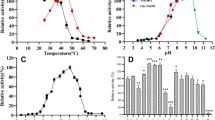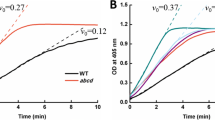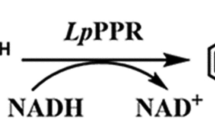Abstract
Objectives
To enhance activity of cis-epoxysuccinate hydrolase from Klebsiella sp. BK-58 for converting cis-epoxysuccinate to tartrate.
Results
By semi-saturation mutagenesis, all the mutants of the six important conserved residues almost completely lost activity. Then random mutation by error-prone PCR and high throughput screening were further performed to screen higher activity enzyme. We obtained a positive mutant F10D after screening 6000 mutations. Saturation mutagenesis on residues Phe10 showed that most of mutants exhibited higher activity than the wild-type, and the highest mutant was F10Q with activity of 812 U mg−1 (k cat /K m , 9.8 ± 0.1 mM−1 s−1), which was 230 % higher than that of wild-type enzyme 355 U mg−1 (k cat /K m , 5.3 ± 0.1 mM−1 s−1). However, the thermostability of the mutant F10Q slightly decreased.
Conclusions
The catalytic activity of a cis-epoxysuccinate hydrolase was efficient improved by a single mutation F10Q and Phe10 might play an important role in the catalysis.
Similar content being viewed by others
Avoid common mistakes on your manuscript.
Introduction
Chiral epoxides and their ring-opened products may react with a variety of nucleophiles, such as alcohols, amines, hydroxylamines, hydrazines, halogens, nitriles etc. Thus they are an important class of chiral synthesis block in organic synthesis and have important applications in medicine, pesticides, spices, fine chemicals industries, etc. (Orru et al. 1999). Epoxide hydrolase (EHs; EC 3.3.2.3) is an ester bond hydrolase (Choi and Choi 2005) that catalyzes the hydrolysis of the epoxides to form the corresponding vicinal diols. Cis-epoxysuccinate hydrolase (ESH) catalyzes the asymmetric hydrolysis of cis-epoxysuccinic acid or its salts to the corresponding tartaric acid or tartrate (Cheng et al. 2014b; Willaert and De Vuyst 2006) (Fig. 1). Although ESH is an efficient biocatalyst, its practical application is still limited due to its stability and catalytic efficiency.
Materials and methods
Strains, plasmids and reagents
Klebsiella sp. BK-58 was stored in our laboratory (Cheng et al. 2014b). Escherichia coli DH5α and E. coli BL21 (DE3) were used for gene clone and expression, respectively. Primers summarized in Supplementary Table 1 were synthesized by Sangon (Shanghai, China). PCR Random Mutagenesis Kit was purchased from Clontech (Dalian, China). EZ-10 spin column genomic DNA isolation kit was purchased from Bio Basic Inc. (Markham, Canada). AxyPrep PCR Cleanup Kit was purchased from Axygen Scientific Inc. (California, USA). 96-well standard microplate (Thermo Scientific) was used for cell culture and colorimetric assay. NcoI, BamHI, T4 DNA ligase and pET-15b (+) were obtained from Sangon (Shanghai, China). Taq plus polymerase and Pfu polymerase were obtained from Tiangen Biotech (Beijing, China). All other chemicals used in this study were of analytical grade.
Cloning and expression of cis-epoxysuccinate hydrolase (ESH)
Klebsiella sp. BK-58 was cultivated as described previously (Cheng et al. 2014b) and its genomic DNA was extracted. The ESH gene (GeneBank Accession Number, KF977193.1) was amplified by primers ESH-F and ESH-R (containing a C-terminal His-tag), digested by NcoI and BamHI, ligated into pET-15b (+) vector (Novagen, Germany) and transformed into E. coli BL21 (DE3). The recombinant pET-15b-ESH bacteria were cultivated at 37 °C for 16 h in lysogeny broth (LB) with 1 % (w/v) NaCl containing 50 μg ampicillin/ml and 1 % (w/v) lactose.
Construction of random mutant library and high throughput screening
The random mutant library of ESH was generated using error-prone PCR and EGAWHOP PCR methods (Miyazaki and Takenouchi 2002). The error-prone PCR was carried out in 50 μl containing 39 μl PCR-grade water, 5 μl 10× Titanium Taq buffer, 1 μl 8 mM MnSO4, 1 μl 2 mM dGTP, 1 μl 50× Diversify dNTP Mix, 1 μl primer mix (RM-F, RM-R), 1 μl template DNA pET-15b-ESH, 1 μl Titanium Taq polymerase. The reaction mixtures were held at 94 °C for 3 min, followed by 30 cycles of incubation at 94 °C for 30 s, 56 °C for 30 s, 72 °C for 1 min, and the final incubation at 72 °C for 10 min. The PCR products were analyzed by 1 % agarose gel electrophoresis assay and purified with PCR Cleanup Kit.
The purified PCR products were used as primers for MEGAWHOP PCR. The reactions were carried out in 50 μl containing 3 μl Template DNA pET-15b-ESH, 10 μl mega primers (the purified error-prone PCR products), 1 μl dNTP Mix, 5 μl Taq plus buffer, 1 μl Taq plus polymerase, 1 μl Pfu polymerase and 29 μl deionized water. PCR was performed at: 68 °C for 5 min, 95 °C for 3 min, followed by 30 cycles of 95 °C for 30 s, 55 °C for 30 s, 68 °C for 7 min, and a final incubation at 68 °C for 10 min. 5 μl PCR products were analyzed by 1 % agarose gel electrophoresis, and the remaining PCR products were digested with restriction enzyme DpnI (2 μl) at 37 °C for 3 h. The digested products were purified by PCR Cleanup Kit, transformed into the chemically competent E. coli BL21 (DE3) and plated on the agar/ampicillin LB plates.
The colonies on the agar plates were picked into 96-well plates containing 200 μl LB medium and 50 μg ampicillin/ml. Four wild-type ESH colonies were picked as control. The plates were incubated at 37 °C for 16 h. Subsequently, each 20 μl culture was transferred into another 96-well plate containing 200 μl LB medium with addition of 1 % (w/v) lactose and 50 μg ampicillin/ml and incubated at 37 °C for 16 h. Then 50 μl 80 % (v/v) sterile glycerol was added into the remaining culture for conservation at 80 °C.
Each 5 μl culture in the expression plates was transferred into another 96-well plate containing 10 μl 1 M disodium cis-epoxysuccinate (pH 8.0), 10 μl 1 % sodium deoxycholate and 75 μl deionized water. The bioconversion was carried out with constant stirring at 37 °C for 60 min. Sequentially 25 μl 1 % ammonium metavanadate, 10 μl 1 M H2SO4 and 115 μl deionized water were added into each well. The content of tartaric acid was determined by the ammonium metavanadate method (Liu et al. 1983). Supplementary Fig. 1 is a brief summary of the method for ESH directed evolution.
Construction of mutants by site-directed mutagenesis
Plasmid pET-15b-ESH was used as the template for site-directed mutagenesis PCR, which was carried out using Quik-Change Lightning Site-Directed Mutagensis Kits (Stratagene) with two reverse complement primers (Supplementary Table 1).
PCR reactions were carried out in 50 μl using Taq plus DNA polymerase and pfu DNA polymerase: 94 °C for 3 min, followed by 25 cycles of 50 s at 94 °C, 30 s at 59 °C, 7 min at 72 °C, and a final incubation at 72 °C for 10 min. After digestion with DpnI (2 μl) at 37 °C for 2 h, the PCR products were transformed into E. coli BL21 (DE3) and plated on agar/ampicillin LB plates. Successful construction of these mutants was verified by sequencing.
Cell cultivation and enzyme purification
Both wild-type and mutant ESHs were expression in E. coli BL21 (DE3), which were cultivated at 37 °C for 16 h in LB medium containing 50 μg ampicillin/ml and 1 % (w/v) lactose. The cells were centrifuged, washed, and suspended in equilibration buffer (50 mM Tris/HCl, 0.5 M NaCl, pH 8.0). Cells were broken by sonication in ice, and the cell debris was removed by centrifugation. The supernatant solution was applied to a His-binding resin (York Biotech, Shanghai, China); the non-absorbed protein fractions were eluted with 50 mM imidazole in equilibration buffer, and then the target protein fractions were eluted with 200 mM imidazole in equilibration buffer. The resulting fractions containing ESHs were pooled, concentrated by ultrafiltration, stored in 10 mM Tris/HCl (pH 7.0) at 4 °C, and identified by SDS-PAGE.
Enzyme activity and protein concentration assays
The reaction mixture contained 50 μl enzyme solution, 750 μl 0.1 M phosphate buffer (pH 8.0) and 200 μl 1 M disodium cis-epoxysuccinate in 1 ml. The reactions were carried out at 50 °C for 15 min and were stopped by adding 400 μl 1 M sulfuric acid. Determination of L(+)-tartaric acid were performed by high performance liquid chromatography (HPLC, Agilent 1200) at 30 °C on a chiral column Astec CLC (150 × 4.6 mm) with a sample volume of 20 μl. The mobile phase was 3 mM CuSO4 (pH 3.2) at 1 ml/min with detection at 254 nm (Pan et al. 2010). One unit (1 U) of ESH activity was defined as the amount of enzyme capable of generating 1 μmol L(+)-tartaric acid per minute at pH 8.0 and 50 °C. Specific activity was defined as the number of units per mg protein. Protein was quantitatively determined by the Bradford method with bovine serum albumin as the standard.
Characterization of the enzymes
The steady-state kinetic parameters of ESH and variants were examined using cis-epoxysuccinate as substrate. The initial velocities of the formation of L(+)-tartaric acid were determined by with cis-epoxysuccinate ranging from 10 to 400 mM. The initial rates obtained were fitted with the Michaelis–Menten equation using Origin 8.0. Enantiomeric excess (ee) value was determined according to Cheng et al. (2014b).
Effects of temperature on the activity of wild-type and mutant ESH were carried out from 4 to 70 °C.
The thermal stability was obtained after pre-incubation of purified enzyme at different temperatures for 30 min. The activity under standard reaction conditions (30 °C, pH 8.0) was defined as 100 %.
Results and discussion
Recombinant plasmid and purification of ESH
The DNA encoding ESH was amplified and introduced into pET-15b (+). The recombinant plasmid pET-15b-ESH map is shown in Fig. 2a. The recombinant plasmid was expressed in E. coli BL21 (DE3) and the recombinant E. coli demonstrated high-level expression of recombinant protein. The recombinant protein was extracted from the soluble fraction of the disruption of E. coli cells and purified by immobilized metal affinity chromatography (Fig. 2b). The purified ESH was smaller than 31 kDa based on 12 % SDS-PAGE, which was consistent with the theoretical molecular weight (30.1 kDa).
Semi-saturation mutagenesis for the 6 conserved sites
According to previous reports (Cheng et al. 2014a), ESH has an α/β hydrolase fold and nine conserved catalytic residues (Carr and Ollis 2009; Ollis et al. 1992; Porter et al. 2015). Therefore, we started from the six conserved sites (Thr52, Arg85, Asn165, Lys195, Tyr201 and Ala219) except for the highly conserved catalytic triad Asp48-His221-Asp224. By semi-saturation for the six conserved sites, we found that the whole cell catalytic activity was almost completely lost (Supplementary Table 2). The results indicated that these sites are irreplaceable in ESH.
Design of mutant library and high throughput screening
Since the semi-saturation mutagenesis for the six conserved sites have no effect on improving enzyme activity, we use the classic error-prone PCR methods, combined MEGAWHOP PCR methods to construct a random mutation library. Directed evolution is an effective route to improve enzymatic properties, screening the large mutant libraries is time-consuming and laborious. Therefore, an accurate and rapid high throughput screening methods is critical to facilitate the screening procedure (Aharoni et al. 2006). We used 96-well plates and a colorimetric method for high-throughput screening of the mutant library. Fortunately, after screening about 6000 mutations, we obtained a positive mutant, F10D (48,200 U/g biomass) compared to wild-type ESH (19,012 U/g biomass).
Creation of saturation mutagenesis library
To further explore the impact of mutations at the site Phe10 on enzyme activity, saturation mutagenesis on this site was carried out. Positive mutants were purified for activity assays (Supplementary Fig. 2), taking into account of the possibility of different expression levels under the same conditions. Among the F10X library (Fig. 3), most proteins exhibited relatively high activity; however, two inferior variants, namely F10Y, F10W, showed a significant decrease in hydrolytic activity. This suggests that aromatic amino acids having large residues at the position 10 lead to stronger steric hindrance and generate a strong repulsion, which leads to an unfavorable interaction and a reduced catalytic rate. In contrast, three superior variants, namely F10Q, F10P, F10 K, were identified, with 229, 182, 180 % increases in hydrolysis activity, respectively. This suggests that the smaller basic amino acid at the position 10 is important for enhancing hydrolysis activity.
Characterization of the enzymes
The kinetic constants, K m , k cat , and k cat/K m , for the formation of L(+)-tartaric were determined and are summarized in Table 1. The enzymatic efficiency (k cat /K m ,9.8 ± 0.1 mM−1 s−1) of F10Q was 185 % higher than wild-type ESH (k cat /K m ,5.3 ± 0.1 mM−1 s−1). ee values (Table 1) showed that the replacement of residue Phe10 did not change the stereospecificity of enzyme.
F10Q showed the highest activity among F10X variants. Therefore, we use F10Q for evaluating the relative activity and thermostability in the evolutionary process. As shown in Fig. 4a, effect of temperature on relative activity of ESH and F10Q were almost the same. But the thermostablility of F10Q was lower than wild-type ESH. The wild-type ESH was most active between 45 and 60 °C and was stable up to 50 °C. F10Q relative activity had a slight decrease from 25 to 40 °C, while the residual enzyme relative activity lost more than 50 % from 40 to 45 °C. Fortunately, however, the residual enzyme relative activity of F10Q was higher than wild-type ESH at any given temperature.
Effects of temperature on the relative activity and thermostability of wild-type ESH and variant F10Q. a The relative activity was assayed from 4 to 70 °C. b Thermal stability was obtained after pre-incubation of the enzymes solution at different temperatures for 30 min. Values are means of three replications ±SD
Conclusion
By semi-saturation for the six conserved sites, we found that the whole cell catalytic activity is almost completely lost, which indicated that these sites were irreplaceable in ESH. We used classical directed evolution techniques to improve the ESH catalytic activity and the relative activity was significantly increased (230 %) by a single mutation, Phe10Gln. In addition, according to the sequence alignments for ESH (Cheng et al. 2014a), we speculated that the point Phe10 may be an important catalytic site of the enzyme, which still needs specific research of protein crystal structures.
References
Aharoni A, Thieme K, Chiu CPC, Buchini S et al (2006) High-throughput screening methodology for the directed evolution of glycosyltransferases. Nat Methods 3:609–614
Carr PD, Ollis DL (2009) α/βHydrolase fold: an update. Prot Pep Lett 16:1137–1148
Cheng YQ, Pan H, Bao W, Sun W, Xie Z, Zhang J, Zhao Y (2014a) Cloning, homology modeling, and reaction mechanism analysis of a novel cis-epoxysuccinate hydrolase from Klebsiella sp. Biotechnol Lett 36:2537–2544
Cheng YQ, Wang L, Pan H, Bao W, Sun W, Xie Z, Zhao Y (2014b) Purification and characterization of a novel cis-epoxysuccinate hydrolase from Klebsiella sp. that produces L(+)-tartaric acid. Biotechnol Lett 36:2325–2330
Choi WJ, Choi CY (2005) Production of chiral epoxides: epoxide hydrolase-catalyzed enantioselective hydrolysis. Biotechnol Bioprocess Eng 10:167–179
Liu Y, Yan X, Zhou W (1983) The colorimetry mensuration for tartaric acid. Ind Microbiol 13:32–37
Miyazaki K, Takenouchi M (2002) Creating random mutagenesis libraries using megaprimer PCR of whole plasmid. Biotechniques 33:1033–1038
Ollis DL, Cheah E, Cygler M, Dijkstra B et al (1992) The α/β hydrolase fold. Prot Eng 5:197–211
Orru RV, Archelas A, Furstoss R, Faber K (1999) Epoxide hydrolases and their synthetic applications. Adv Biochem Eng Biotechnol 63:145–167
Pan HF, Xie ZP, Bao WN, Zhang JG (2008) Optimization of culture conditions to enhance cis-epoxysuccinate hydrolase production in Escherichia coli by response surface methodology. Biochem Eng J 42:133–138
Pan HF, Bao WN, Xie ZP, Zhang JG, Li YQ (2010) Immobilization of Escherichia coli cells with cis-epoxysuccinate hydrolase activity for d(-)-tartaric acid production. Biotechnol Lett 32:235–241
Porter JL, Boon PL, Murray TP, Huber T, Collyer CA, Ollis DL (2015) Directed evolution of new and improved enzyme functions using an evolutionary intermediate and multidirectional search. ACS Chem Biol 10:611–621
Willaert R, De Vuyst L (2006) Continuous production of L(+)-tartaric acid from cis-epoxysuccinate using a membrane recycle reactor. Appl Microbiol Biotechnol 71:155–163
Acknowledgments
This project is supported by the National Natural Science Foundation of China (31300661) and the High Technology Research and Development Program of China (863 Program) (2012AA06A203).
Supporting Information
Supplementary Table 1—Primers used in this study.
Supplementary Table 2—Characterization of wild-type and mutant ESHs.
Supplementary Fig. 1—Summary of the strategy for directed evolution of ESH.
Supplementary Fig. 2—SDS-PAGE of purified ESH and mutant ESHs.
Author information
Authors and Affiliations
Corresponding author
Electronic supplementary material
Below is the link to the electronic supplementary material.
Rights and permissions
About this article
Cite this article
Zhang, C., Pan, H., Yao, L. et al. Single point mutations enhance activity of cis-epoxysuccinate hydrolase. Biotechnol Lett 38, 1301–1306 (2016). https://doi.org/10.1007/s10529-016-2078-3
Received:
Accepted:
Published:
Issue Date:
DOI: https://doi.org/10.1007/s10529-016-2078-3








